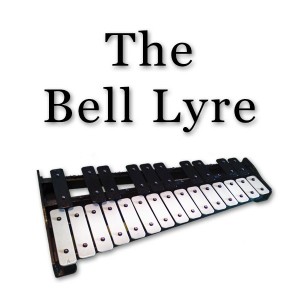The bell lyre is usually a two octave glockenspiel – although they can be larger or smaller. Designed to be lightweight and portable, some are built in the shape of a lyre and are played upright supported by a strap around the musician’s waist. The instrument in this library is known as a flatbed bell lyre and can be supported by a special shoulder mount when played during a performance.
We recorded multiple sample sets using three different mallets: soft rubber, hard rubber, and plastic. The instrument uses true legato transition samples to enable you to perform realistic glissandi. Nearly every patch is sampled chromatically with recorded repetitions (round robin) and recorded dynamic levels that respond to MIDI velocity. We made use of velocity scaling and elegantly processed the samples to maintain consistent quality and volume levels across each patch.
In addition to the recorded repetitions we have provided a scripted repetition that uses a number of techniques to create slight variations for every note, just like a live musician. There are literally thousands of subtle variations that our intelligent repetition script will perform and it will never repeat a single variation more than once in every 128 repetitions per note.
Through advanced scripting we have made it incredibly easy to achieve a realistic performance with minimal programming. The instrument was recorded dry using a single condenser microphone in a close mic position. We recorded through an analogue mixer in order to retain a warmer, more natural sound, and used high quality A/D converters before fine tuning and editing each sample.
Main Interface
The user interface is intended to be clean, minimal, and simple to use. Our intention is to be able to produce realistic performances in a sequencer environment where behind the scenes CC controls are used more than the instruments visual interface. Such CC controls are fully customisable within the interface.
The interface has been designed to make use of Kontakt 4’s advanced scripting features. The controls are straightforward and easy to access, and offer lots of creative options. The following sections detail the functions of each control.
- Repetition Mode: We wanted to create instruments where every time a note is played it sounds slightly different, just like a live musician. To achieve this we use pitch shifting and micro-tuning techniques, combined with multiple repetition recordings, and original intelligent repetition scripting.
- In repetition mode one – basic round robin – the instrument will play through the various recorded repetitions in order. Most patches have three recorded repetitions.
- In mode two – intelligent repetition – the instrument will use various scripted and recorded techniques to achieve slight variations in the note. There are literally thousands of different, subtle, variations that the script will perform and it will never repeat a single variation more than once every 128 repetitions, per note.
- Repetition Reset: This will reset both the basic and intelligent repetition systems. The button is automatically turned off once a note is pressed unless controlling it via a CC.
- Glissando Speed Control: Controls the playing speed threshold for triggering glissandi notes. Our high precision script determines how fast two adjacent notes are played, if the notes are played quicker than the value of the speed control a transitioning note is triggered, either up or down the scale. Requires the glissando on/off CC to be turned on. Values are in milliseconds.
- CC Settings Button: This button will take you to the CC setup panel – detailed in the next section. Once in the CC setup panel this button can be used, while holding the control key, to scroll through various CC presets. This button will also take you back to the main panel.
Key Switches
Soft Rubber Mallet
Activated using the key switch C0.
Hard Rubber Mallet
Activated using the key switch D0.
This patch contains true legato transition samples allowing you to perform realistic glissandi on the instrument. This is triggered by your playing speed and the glissando continuous controller (64 by default).
Hand Damped
Activated using the key switch E0. The samples for this articulation are hand damped; meaning that after the note has been struck a hand is
placed on the bar to stop the sound. The damped samples are played as the key is released allowing you to decide how long the note sounds before it is damped.
This key switch is only effective when using either the hard or soft rubber mallet articulations.
Plastic Mallet
Activated using the key switch F0.
Continuous Controller Settings
In this panel you can choose which continuous controllers (CCs) are used within the instrument. You can also use the CC Settings Button, as described above, to select various preset options. When using the CCs in your sequencer any setting below 64 is interpreted as off and anything above is on. We recommend that you don’t use CC numbers that are used by Kontakt.
Each CC number can only be used once, if you try and select a CC number that is already allocated to another control the CC will be set to the next available number.
The Mode CC is used to toggle the repetition mode between basic round robin and intelligent repetition.
The Reset CC enables or disables the repetition reset button. By using repetition mode one and leaving the reset CC turned on you can effectively disable the repetition function entirely.
The Speed CC allows you to control the glissando speed threshold. This performs the same task as moving the glissando speed control on the main panel
The Glissando On/Off CC allows you to enable or disable the glissando. There is no interface control for this feature and it can only be operated via CC.
Acknowledgements
Produced by: David Healey
Scripting: Rosie M. Banks.
Recording and Editing: S. W. Erdnase.
Graphic Design: Nicolas Bourbaki.




